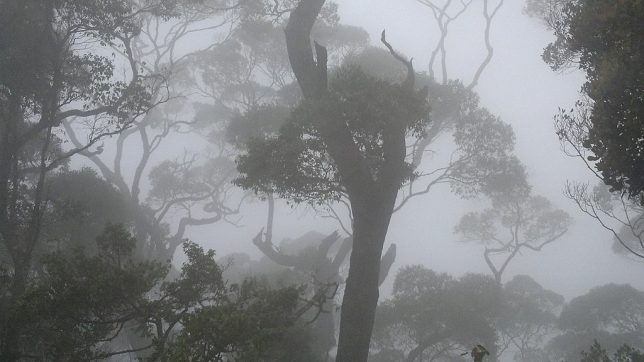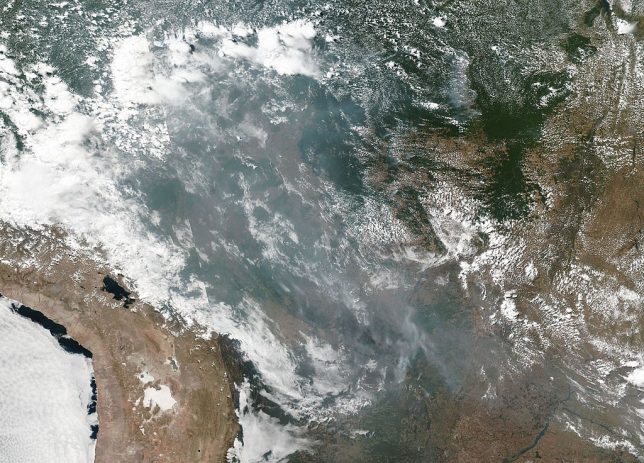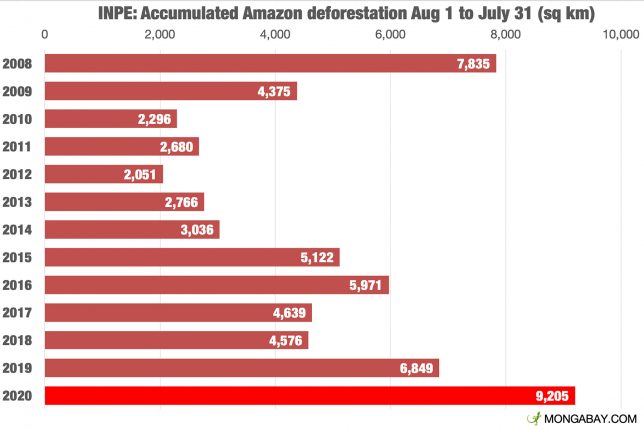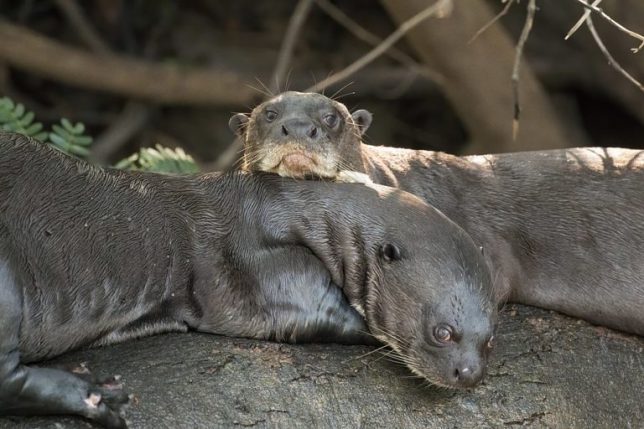Keeping forests standing is one of the most effective and important ways to keep the world below dangerous levels of warming.
by Rosamaria Loures, Sarah Sax, Mongabay, August 21, 2020 (CC BY-ND 4.0).
- Recognition of the role that Indigenous land plays in forest protection, biodiversity conservation and environmental health has been growing, but less attention has been paid to the role of women.
- An increasing body of research and experts are calling for a greater recognition of the link between gender equality and environmental protection.
- Examples like the Guajajara “women warriors” in the Brazilian Amazon show how greater inclusion of women can benefit conservation goals.
NEW YORK — On an early December morning last year in the state of Maranhão, Brazil, half a dozen members of the Indigenous Guajajara people packed their bags with food, maps and drone equipment to get ready for a patrol. They said goodbye to their children, uncertain when, or whether, they would see them again. Then, they hoisted their bags over their shoulders and set out to patrol a section of the 173,000 hectares (428,000 acres) of the primary rainforest they call home.
This is the Caru Indigenous Territory, where the Amazon peters out toward the northeastern coast of Brazil, and it contains some of the last stretches of intact, contiguous forest in Maranhão. It is also under increasing threat: this part of Brazil has been ravaged by some of the country’s highest rates of deforestation and land conflicts over the past decade. Patrols led by Indigenous groups like theirs, known often by the moniker of “Forest Guardians,” have been instrumental in enforcing protections and preventing loggers from entering Indigenous territories. Patrols and their enforcement tactics, which have been ramping up over the past decade, have also resulted in community members being threatened, attacked, and killed — as in the case of Paulo Paulino Guajajara last year, who was murdered in a neighboring Indigenous territory.
But members of the patrol that set out through the forest last December don’t call themselves guardians; they prefer warriors. And they differ in one other notable aspect: they are all women.
“Why did we take the initiative? Because we are mothers. If we don’t act, there would be no forest standing,” said Paula Guajajara, one of the “women warriors of the forest,” in a public event last year.
Called guerreiras da floresta in Portuguese, this is the name these women have given themselves. They are in many ways an embodiment of what policymakers, politicians and scholars around the world say is a necessary shift toward gender equality in environmental movements. And they are contributing not just womanpower to the patrols — they are also helping to diversify the tactics and forge new partnerships.
In Brazil in particular, where protecting intact forests is one of the cheapest, easiest and most effective solutions for combating climate change, the work they are doing is literally saving the world.
Creating a Space and Finding Their Voice
Actively patrolling their land for invaders is nothing new to the Guajajara; Indigenous people have more than 500 years of experience in this. Today, they use satellite technology and coordinate efforts with outside law enforcement to achieve their goals. This approach is relatively new, but its use has been on the rise in recent years.
“Across the country more of these groups are forming because of government inaction — or worse, because the government is actively trying to exploit their lands,” Sarah Shenker, campaign coordinator for Survival International’s Uncontacted Tribes team, said in an interview. These groups are primarily men, although women are sometimes included in the patrols. But according to Shenker, as well as other experts interviewed for this article, to have “forest guardian” groups made up solely of women is unique.
The women warriors were formed six years ago, an offshoot of a program developed by Indigenous organizations and the Brazilian government and implemented by the Ministry of the Environment to enhance the territorial and cultural protection of Indigenous people, called Projeto Demonstrativo de Povos Indígenas (PDPI) in Portuguese. At the time, the predominantly male forest guardians were attempting to end illegal logging and the sale of wood from their territory — a task that was proving extremely difficult. Seeing this, the women stepped in and formed their own group consisting originally of 32 women.
“In order not to let the project end, we, the Guajajara women, entered and took over the project,” Cícera Guajajara da Silva, one of the women warriors, said in an interview.
But the path to being taken seriously and treated as equals has been long.
“To seek partnership, we walked, talked, slept on the floor — all in order to seek improvement for our community,” Paula Guajajara said, recalling the initial difficulty in being heard and taken seriously inside and outside of the communities. Their patience has paid off, and the women are quick to point out the support and close collaboration of the male forest guardians that has allowed them to combat the greater goal of stopping illegal logging. “Today we have the women warriors who work together with the forest guardians,” Paula Guajajara said. “We’ve already evicted a lot of loggers. If we hadn’t acted, there would be no forest standing.”
Many of the married women had already been acting independently, accompanying their husbands in some activities, according to Gilderlan Rodrigues da Silva, the Maranhão coordinator of the Indigenous Missionary Council (CIMI), a Catholic Church-affiliated organization, who has worked with the women warriors. “But, from the moment they created the women’s group, they gained strength and visibility,” he said in an interview. “Once they were formed, there was this very strong change. Both in the context of decreasing the invasions and waking up to the collective awareness to protect the territory.”
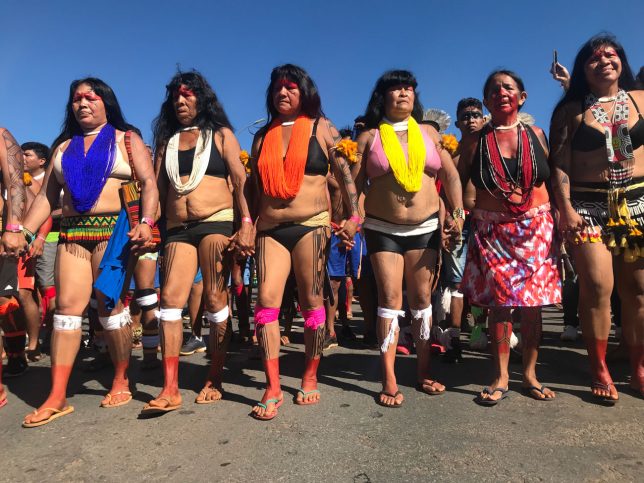
The Direct and Indirect Impacts of Greater Inclusion
The results are clearly visible. In 2018, there was only 63 hectares (156 acres) of deforestation in the reserve, compared to 2016, when deforestation reached a high of 2,000 hectares (4,940 acres), according to Global Forest Watch. “The biggest achievement I see today in my village is because of the territorial protection, there are no loggers within our territory, and we managed to combat the sale of wood,” Cícera Guajajara da Silva said.
The women’s association has also been instrumental in connecting with other Indigenous groups similarly seeking to protect their territories, such as the Ka’apor, Awa-Guaja, and other Guajajara communities.
“There are 16 Indigenous territories in Maranhão — we have to seek unity to move forward in our struggle,” said Maísa Guajajara, one of the original women warriors. Through coordination with other women’s groups, like the Articulation of Indigenous Women of Maranhão (AMIMA), they were able to bring 200 Indigenous women from around the state together for the first time in 2017 to talk about various issues, including territorial protection, reforestation, and environmental education.
“This whole movement is extremely important because it shows this strength, and that women have a lot to contribute to the movement because they are part of the territory and are concerned with it, and with future generations,” Rodrigues da Silva told Mongabay.
They don’t just coordinate with other Indigenous groups; they also conduct training with neighboring communities about the importance of environmental conservation. “Not all women do surveillance work because we know it is dangerous work, but there are always some who do,” Maísa Guajajara said. “The warriors generally do more surveillance activities outside the territory, we give lectures around our territory to talk about the invasions within our territory, and we raise awareness in the villages by talking about the importance of keeping nature standing.” For example, the women warriors are partners in the Mãe D’água (Mother of Water) project that, together with the Brazilian NGO Fórum da Amazônia Oriental (FAOR), provides support for Indigenous women to strengthen their collective actions against ongoing deforestation and water pollution. These actions include visits to nearby riverine communities in which the women warriors explain their ways of living, such as hunting and rituals, to their neighbors. For the women warriors, the more that their neighbors know about Guajajara culture, the more they will respect their actions to defend their territory.
Why Women are Key to Forest Conservation
In Brazil, and around the world, Indigenous women are increasingly at the forefront of environmental movements.
“The struggle of Indigenous women happens in different ways, day by day. If I am here today, I am the fruit of the women who came in front of me,” Taynara Caragiu Guajajara, a member of the Indigenous women’s collective AMIMA, said during a live online event in April. “In the context of the world we live in today, we have been conquering space inside and outside the community. We Indigenous women have not always had that voice … but today the struggle is driven by Indigenous women, we are the ones who are in charge of the struggle.”
Women are increasingly leading the struggle on issues like climate change, but their voices are heard much less often then men’s — to the detriment of everyone. This is partially a byproduct of gender bias in journalism itself.
In 2015, of every four people interviewed, mentioned or seen in the news worldwide, only one was a woman, according to a report by the Global Media Monitoring Project, which releases its findings every five years. A closer look at the data shows that even when women are interviewed, it is for personal quotes, rather than for their expertise. It’s a figure that seems to have barely budged over the past few years, although some newsrooms are starting to actively change that.
Studies show that, in general, women receive greater exposure in newspaper sections led by female editors, as well as in newspapers whose editorial boards have higher female representation. But men are disproportionately represented from editors through to reporters, meaning that critical issues for women often go unreported. One of these areas is precisely the connection between conservation solutions and gender equality.
Women are disproportionately affected by climate change and environmental degradation. Mounting evidence shows that gender gaps and inequalities, such as inequitable land tenure and women’s reduced access to energy, water and sanitation facilities, negatively impact human and environmental well-being. The climate crisis will only make gender disparities worse.
Gender-based violence against women environmental human rights defenders in particular is on the rise, and increasingly normalized in both public and private spheres, making it more difficult for women to get justice. As Indigenous communities are often on the front lines of defending their territories, resources and rights from extractive projects and corporate interests, Indigenous women in particular face a two-headed beast of gender-based violence and racism.
“We fought to defend our territory against invasions and we sought this autonomy to fight for rights,” Taynara Caragiu Guajajara said in an interview. “Being a woman is difficult within the macho society, but being an Indigenous or black woman becomes even more difficult, because the prejudice is so great.”
Having more women involved in everything from environmental decision-making to climate politics benefits society at large. Higher female participation in policymaking increases the equality and effectiveness of climate policy interventions; evidence shows that high gender inequality is correlated with higher rates of deforestation, air pollution and other measures of environmental degradation.
Yet less than 1% of international philanthropy goes to women’s environmental initiatives, and women are continuously left out of decisions about land and environmental resources.
“The global community cannot afford to treat nature conservation and the fight for women’s equality as separate issues — they must be addressed together,” said Grethel Aguilar, the acting director-general of the International Union for the Conservation of Nature (IUCN), on international women’s day this year.
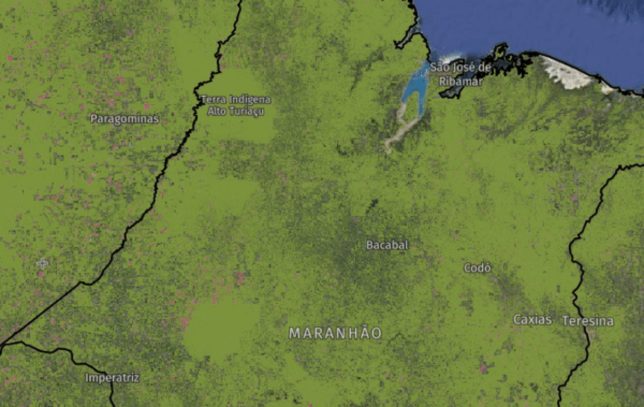
Why the Fight for Indigenous Territorial Rights in Brazil Matters to Conservation
Tracking tree cover loss in Maranhão over the past two decades shows the crucial importance of Indigenous territories in protecting intact forest. Viewed from space, as the forest cover rapidly disappears, the outlines of Indigenous territories become more and more distinct.
“These Indigenous territories are islands of green in a sea of deforestation in one of the worst deforested places in Brazil,” Shenker said.
The Caru Indigenous Territory, for example, has seen 4% forest loss in comparison to the state of Maranhão, which has lost almost a quarter of its tree cover since 2000, according to Global Forest Watch data. Alongside the various other benefits that come with forest preservation, the forests in the Caru Indigenous Territory are also home to some of the last uncontacted Awá people; video of of two Awá men taken in the neighboring Araribóia Indigenous Territory made international headlines last year.
These patches of intact, tropical forests are also the crux of “natural climate solutions” protection. These solutions essentially entail stopping deforestation, improving management of forests, and restoring ecosystems, and could provide more than one-third of the cost-effective climate mitigation needed between now and 2030 to stabilize warming to below 2° Celsius (3.6° Fahrenheit).
According to one of the seminal papers on natural climate solutions, the single most effective approach in the tropics has proven to be actively protecting intact forests. Protecting intact forests offers twice as much of the cost-effective climate mitigation potential as the second best pathway, reforestation. The Amazon as a whole plays a vital role in mitigating climate change by absorbing and storing carbon dioxide in its forests. When cut down, burned, or degraded through logging, the forest not only ceases to fulfill this function, but can become a source of carbon emissions.
“Protecting and or conserving intact ecosystems is the number-one priority,” said Kate Dooley, a research fellow at the Australian-German Climate & Energy College at the University of Melbourne, who has authored several papers on the potential of forests as a natural climate solution. “Way-way-way down the line is planting trees. And even then, it needs to be the right kind of trees.”
Of all the countries in the world with some kind of tropical rainforest, Brazil holds more mitigation potential than 71 of the 79 countries combined, according to a recent paper on this topic. It isn’t too hyperbolic, then, to say that groups like the women warriors are protecting humanity’s last best hope for a livable future.
“Plenty of research showing that forests are more intact in collectively held lands,” Dooley said. “With or without secure land tenure those lands are more intact and less degraded.” According to a report in 2018 by the Rights and Resources Initiative, almost 300 billion metric tons of carbon are stored in collectively managed lands across all forest biomes, and numerous studies have found that the best way to protect forests is to empower the people who live in them, granting them land rights and legal standing.
This is especially true for Indigenous-held lands in places like Brazil. Between 2000 and 2015, legally designated Indigenous territories in Brazil saw a tenth the amount of forest loss than non-Indigenous territories. Brazil is home to approximately 900,000 Indigenous citizens from 305 peoples, most of who live in Indigenous territories. Even so, more than half of the locations claimed by Indigenous groups have not yet received formal government recognition.
“Surveillance and inspection by Indigenous peoples is extremely important, as they are the ones who know the territory and the region best,” Rodrigues da Silva said. “On the other hand, unfortunately they are left alone, the Indigenous body responsible for inspection ends up not fulfilling the role and leaving only the Indigenous people.”
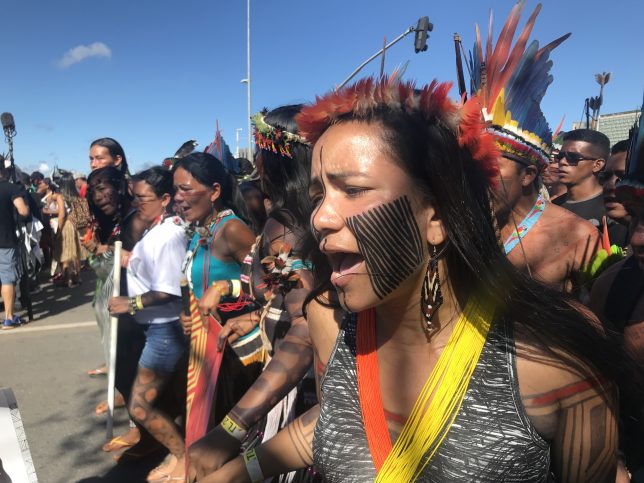
Prevailing Amid Growing Threats
Despite an increasingly hostile government, the women warriors say they are committed to continuing their monitoring, surveillance and educational activities, and are hoping to inspire other groups to do the same.
“Today women act 100% in defense of the territory,” Paula Guajajara said. “Today we are serving as an example.“
But the work is daunting.
Brazil has the rights of Indigenous people written into its constitution of 1988, and is a signatory to the International Labour Organization’s (ILO) Indigenous and Tribal Peoples Convention. Yet, the current administration of President Jair Bolsonaro has made it clear that Indigenous peoples won’t be allowed to comment on infrastructure projects affecting Indigenous territories in the Amazon. Bolsonaro’s administration has also proposed opening up Indigenous territories to extractive activities — something the constitution specifically prohibits.
Hundreds of people have been killed during the past decade in the context of conflicts over the use of land and resources in the Amazon — many by people involved in illegal logging — according to the Pastoral Land Commission (CPT), a Catholic Church-affiliated nonprofit that follows land conflicts.
But perpetrators of violence in the Brazilian Amazon are rarely brought to justice.
Of the more than 300 killings that the CPT has registered since 2009, only 14 ultimately went to trial. Maranhão, where the Guajajara live, is among the most dangerous states for Indigenous people in Brazil: more attacks on Indigenous groups were reported here than anywhere else in 2016, according to data from the CPT.
The coronavirus poses an additional threat to Indigenous peoples throughout the Amazon and especially in Brazil, where the death rate from COVID-19 is much higher than the national rate.
“The surveillance expeditions are stopped by the pandemic, we are not doing surveillance, to care for everyone in the village,” Cícera Guajajara da Silva said. “Especially in order to protect our health, because nobody knows who the types of people [invaders] are inside the forest, they may even be infected with the virus, the invader himself can bring the virus to our territory, and that’s why we stopped [the expeditions], we are now only sheltering in the village.”
But despite the mounting difficulties, the women warriors are committed to continuing their work.
“We have the courage to defend our territory,” Maisa Guajajara said. “I am a woman and I will fight against all the threats that are in our territory.”
Article published by Genevieve Belmaker.

